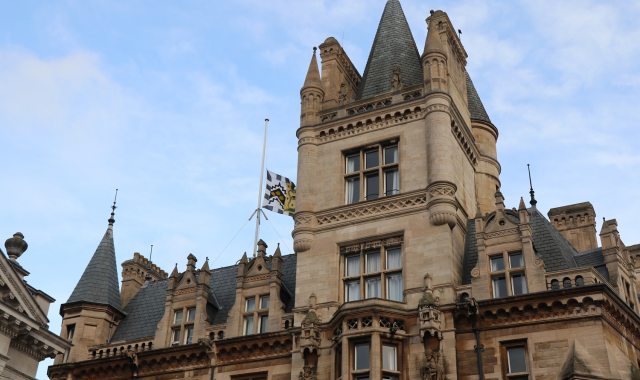The Caian, the coffee pot and the webcam - an award-winning combination
- 23 November 2017
- 6 minutes
An adventure in the early days of the Web involving a coffee pot, a basic camera and a cult global following has helped a Caian computer scientist win an international award celebrating internet innovation.
Dr Quentin Stafford-Fraser, a Caian ComSci graduate who also worked at Caius and did his PhD at the College, has won a Lovie Lifetime Achievement Award for his myriad contributions to computer science, and most notably his role in the invention of the first webcam. The Lovies, the European equivalent of the US Webby awards, are named after Victorian computer science pioneer Ada Lovelace, and honour the best of the European internet.
The extraordinary tale of the first webcam – whose Caius link is little-known – goes back to 1991, when the University of Cambridge Computer Laboratory found itself struggling with a tricky problem. A team of 15 researchers was scattered all over the building in different labs and on several floors, but there was only one coffee filter machine, located in the Trojan room. “We all shared this rather unappealing machine which made pretty terrible coffee at any time, but it was especially terrible if you didn’t get it fresh,” Quentin recalls. “People upstairs didn’t know when the coffee was ready, and we thought this wasn’t very fair. A good supply of coffee is important in computing research.”
Fortunately, the inventive researchers – many of them working on developing multimedia over computer networks - had a solution at hand. Quentin and colleague Dr Paul Jardetzky rigged up a spare video camera and frame grabber to monitor the pot, with the image refreshing around three times a minute. They wrote software to capture and then display the small, grainy images in a corner window on the desktops of internal networked computers – and, hey presto, the coffee information gap was closed.
The caffeine-inspired innovation took a vital further step some two years later, however, once web browsers began to become capable of displaying images. The Cambridge researchers, observing that most images were of results graphs or institutional logos, wondered whether changing images could also be “broadcast” via the web. “We wanted to know what would happen if you pointed a web browser at an image and the image was not the same every time,” says Quentin. “We asked ourselves where we could find a source of constantly changing images, and thought, ‘Ah, the coffee pot’.”
On 22 November 1993, the first images of the pot appeared on the world wide web, available to anyone with a connected computer and the inclination to look. And look they quickly did, as word of the pot – in all its glorious mundanity – spread around the globe. A man from Australia contacted the Lab to ask why the image on his screen was dark, prompting the team to set up an Anglepoise lamp to be turned on overnight so Southern Hemisphere fans could see the pot during their daytime.
Visitors started arriving to see the coffee pot, with one even turning up at the Tourist Information Centre in Cambridge to ask for directions. The coffee cam was an international news and media story, making the front pages of the Washington Post and the London Times; appearing on BBC Breakfast and being mentioned in the BBC Radio 4 soap opera, The Archers. A Japanese television network covered the story - its report provides one of the few surviving images of the webcam footage of the pot.
After three years, the pot achieved its millionth view, and the Times pronounced it the biggest tourist attraction in East Anglia, more popular even than King’s College Chapel.
The fascination was partly down to a sense of novelty at live video that may be hard for younger web users to imagine, Quentin believes. “In the early days of the web, you were going through static pages, and all of a sudden you came across this window which was a portal back into the real world, albeit not a very interesting window!”
There is also something deeper and more mysterious behind our fascination with peeping from afar, he suggests. “We have always had something deep in the psyche that makes us want to see things at a distance. There are many myths in fiction about ‘seeing stones’ that allow you to see a bit of a world far away – the palantíri in the Lord of the Rings for example, or the painting of the sailing ship in The Voyage of the Dawn Treader.”
The coffee pot also has a symbolic significance in terms of the development of the internet and digital technology. “The things that made the coffee pot a success and easy to do were also the things that made the web a success. We had some data from another experiment, and it was trivial to turn this into data other people could easily see. We didn’t have to ask anybody’s permission, consult lawyers or pay any licence fees. And it was global, which was fairly rare at the time, when most networks were a lot more localised. That global element, and the re-use of information we already had, were some of the indicators that suggested the web was going to be really big.”
For all its quirkiness, the story of the development of the webcam is an archetypal tale of invention: a solution designed to address one practical problem (cold coffee) turns out to be a key leap forward in the development of technologies used in everything from Skype and Facetime to the camera showing the snow levels in Alpine ski resorts.
The timing of the invention, and the freedom then available for experimentation, was critical, Quentin believes: “This was very powerful technology with a very low barrier to entry. Had any corporation owned this thing, we would not have the web as we have it today.”
The story of the original pioneering webcam ends in 2001, when the Computer Lab was moving to new premises and the camera was switched off in the clear-out. The only money ever made from the invention came when the coffee pot was auctioned on Ebay. The winning bid of £3,350 came from the German magazine Der Spiegel who put it back onto the net via webcam, though this time without any coffee.
The Lifetime Achievement Lovie Awards recognises the importance of the webcam in Quentin’s career, but also his myriad - and ongoing - contributions to computer science (including an early spell as Caius' first Computer Officer). He now holds a part-time research post back at the Cambridge Computer Lab, where he is currently working on the Endeavour project, and runs Telemarq, a company mixing strategy consultancy, software development, photography, teaching and writing, with some products of its own in the pipeline.
The awards committee praised Quentin's “ingenuity, technical prowess and faith in the power of digital technology to connect us”. His invention of the first livestream “paved the way for the present-day proliferation of live video chat online and on handheld devices,” judges said. “Through his invention of the XCoffee client program in 1991 - utilising a video feed that showed a coffee pot captured in just three frames per minute - Stafford-Fraser took the first step toward making the connection between live video and the web, laying the groundwork for how we now share video online.”
- About The Lovie Awards
The mission of the Lovie Awards is to recognise the unique and resonant nature of the European Internet community - from Europe’s top web and creative networks and content publishers, to cultural and political organisations and individual creators. Now in its seventh year, The Lovie Awards continues to celebrate the most resonant and pertinent stories in Europe. With nearly 1,500 entries from over 33 countries across Europe, the Awards reflect the tremendous growth of the Internet as a tool for business and everyday lives. Work in English, French, German, Spanish, Dutch, Swedish and Italian is judged by native speakers in five main category types: Websites, Mobile Sites, Apps & Podcasts, Internet Video, Online Advertising and Social.


